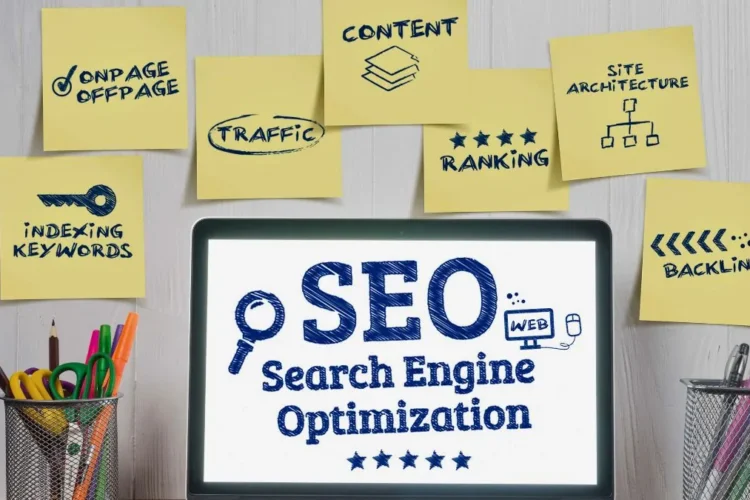If you grow and want to get more leads, sales, bookings, etc. from search engines through SEO, a well-structured website architecture is a must. It not only improves the user experience but also helps search engines crawl and index your information efficiently. As we move towards the next generation, it is important to align your website architecture with the latest best practices to stay ahead in search rankings.
Table of Contents
Why Website Architecture Matters for SEO
Website architecture refers to the structure and organization of your website’s pages and how they interlink. A well-structured site:
✅ Improves crawlability for search engines
✅ Enhances user experience (UX)
✅ Boosts internal linking and page authority
✅ Reduces bounce rates and increases engagement
Now, let’s dive into the-
Best Practices to Optimize Website Architecture for SEO
1. Maintain a Clear and Logical Website Structure
A well-organized website structure enhances user experience and aids search engines in effectively crawling and indexing your site.
Why It’s Important
- User Navigation: A clear structure allows visitors to find information quickly and easily.
- SEO Benefits: Search engines can better understand and rank your content.
- Scalability: A logical hierarchy makes it easier to add new content without disrupting the existing structure.
Recommended Structure
Visualize your website’s architecture as a pyramid:
- Homepage: The main entry point of your website.
- Primary Categories: Broad sections like Services, Products, or Blog.
- Subcategories: More specific topics under each primary category.
- Individual Post and, Pages: Detailed content pages or blog posts.
Example:Home > Services > SEO > On-Page SEO
2. Use a Flat Site Structure (Avoid Too Many Layers)
A flat architecture ensures that important pages are no more than 3-4 clicks away from the homepage. Deeply buried pages may get less crawl attention.
❌ Avoid:Home > Category > Subcategory > Sub-subcategory > Page
✅ Prefer:Home > Category > Page
3. Optimize URL Structure
Clean, descriptive URLs improve readability and SEO. Follow these rules:
✔ Use hyphens (-) instead of underscores (_)
✔ Keep URLs short & keyword-rich
✔ Avoid unnecessary parameters (?id=123)
Bad URL:nexgend.com/services/seo?id=456
Good URL:nexgend.com/seo-services
4. Implement a Strong Internal Linking Strategy
Internal linking means connecting one page of your website to another. It helps both users and search engines find related content easily.
Why It’s Important:
- Improves navigation for users by guiding them to relevant content.
- Helps search engines understand the structure of your site and index more pages.
- Distributes link equity (ranking power) from high-authority pages to others.
Best Practices:
- Link Relevant Pages Within Content
Example: If you’re writing a blog post about “Local SEO Strategies,” and you have a page about “Google My Business Optimization,” link them together.
2. Use Descriptive Anchor Texts
❌ Bad: Click here
✅ Good: Read our guide on keyword research for SEO
Use anchor texts that clearly tell users (and Google) what the linked page is about.
3. Avoid Broken Links
Use tools like Google Search Console or Screaming Frog to regularly scan and fix broken links. Broken links create a poor user experience and can affect your SEO performance.
4. Create Topic Clusters
Structure your content by linking related pages together. For example:
- Main Page: SEO Services
- Linked Pages: On-Page SEO, Technical SEO, Local SEO, Ecommerce SEO
This forms a strong network of related content, improving site architecture and topical authority.
5. Create a Simple & Intuitive Navigation
Users (and search engines) should find key pages easily.
Best Practices:
1. Clear Main Menu
Include only the most essential links:
- Home
- Services
- About Us
- Blog
- Contact
💡 Example from NexGenD:Home | SEO Services | Web Development | PPC & Meta Ads | Blog | Contact
2. Footer Navigation
Use your footer to add secondary links like:
- Privacy Policy
- Terms & Conditions
- FAQs
- Careers
3. Add Breadcrumbs
Breadcrumbs show users where they are on your site.
Example:Home > Services > SEO > Local SEO
They improve UX and give Google more context about your content structure.
4. Keep It Consistent
Use the same navigation across all pages to create a seamless browsing experience.
6. Optimize for Mobile & Core Web Vitals
More than half of web traffic comes from mobile devices, and Google uses mobile-first indexing — so your mobile site is the primary version they evaluate.
Focus on 3 Key Metrics (Core Web Vitals):
1. LCP (Largest Contentful Paint) – Measures how fast the largest content block loads.
Goal: Under 2.5 seconds
→ Use compressed images, lazy loading, and fast hosting.
2. FID (First Input Delay) – Measures how fast a page responds to user interaction.
Goal: Under 100ms
→ Minimize JavaScript and use lightweight plugins.
3. CLS (Cumulative Layout Shift) – Measures visual stability.
Goal: Less than 0.1
→ Avoid elements (like ads or buttons) shifting while the page is loading.
Best Practices:
1. Responsive Design
Your website should adapt to all screen sizes—mobile, tablet, desktop. Use flexible layouts and mobile-friendly fonts.
2. No Intrusive Pop-Ups
Pop-ups that cover the content on mobile devices can hurt both UX and SEO.
Use slide-ins or banners instead.
3. Test Your Site
Use tools like:
7. Use XML Sitemaps & Submit to Google Search Console
An XML sitemap acts like a roadmap for search engines, helping them discover and index all your important pages efficiently. Without a sitemap, some pages (especially new or deep-linked ones) might get overlooked, hurting your SEO efforts.
Why XML Sitemaps Matter
✔ Faster Indexing – Search engines like Google prioritize crawling pages listed in sitemaps.
✔ Better Crawl Budget Utilization – Ensures bots focus on key pages instead of wasting time on low-priority URLs.
✔ Helps with Large or New Websites – If your site has hundreds of pages or frequent updates, a sitemap ensures nothing gets missed.
How to Create & Submit an XML Sitemap
- Generate Your Sitemap
- Use tools like Yoast SEO (WordPress), Screaming Frog, or online generators.
- Ensure it includes all important pages (excluding no-indexed or duplicate content).
- Submit to Google Search Console
- Go to Google Search Console > Sitemaps > Enter your sitemap URL (e.g.,
nexgend.com/sitemap.xml). - Monitor for errors (like blocked URLs) and fix them promptly.
- Keep It Updated
- Whenever you add new pages or remove old ones, update your sitemap.
- For dynamic sites (e.g., eCommerce), use auto-updating sitemap plugins.
8. Fix Broken Links & Redirects
Broken links (404 errors) frustrate users and signal poor site health to search engines, leading to lower rankings. Fixing them improves user experience (UX) and SEO performance.
How to Find & Fix Broken Links
✔ Use SEO Audit Tools – Tools like Screaming Frog, Ahrefs, or SEMrush scan your site for broken links.
✔ Check Google Search Console – The Coverage Report highlights 404 errors.
Best Practices for Handling Broken Links
- 301 Redirect Deleted Pages
- If a page is removed, redirect it (301) to the most relevant existing page.
- Example: If
/old-serviceis deleted, redirect it to/new-service.
- Avoid Redirect Chains
- Chains like
Page A → Page B → Page Cslow down crawling. - Always redirect directly to the final destination.
- Custom 404 Page
- A helpful 404 page with navigation links can retain visitors who land on broken URLs.
9. Optimize for SEO-Friendly Pagination
Pagination (splitting content across multiple pages, like blog archives or product listings) can create duplicate content issues if not handled properly. Here’s how to optimize it for SEO:
1. Use rel="next" & rel="prev" Tags
- These tags tell Google that paginated pages are part of a series.
- Example:
<link rel="prev" href="https://nexgend.com/blog/page1" />
<link rel="next" href="https://nexgend.com/blog/page3" /> 2. Set a Canonical Tag to Avoid Duplicate Content
- Google may treat each paginated page as separate content, diluting rankings.
- Add a canonical tag pointing to the first page or a “View All” version:
<link rel="canonical" href="https://nexgend.com/blog/" /> 3. Alternative: Infinite Scroll + Load More Button
- Some sites (like eCommerce) use infinite scroll, but this can harm SEO if not implemented correctly.
- Combine it with lazy loading and proper indexing signals.
10. Minimize Duplicate Content with Canonical Tags
Duplicate content is one of the most common SEO issues that can dilute your rankings and confuse search engines. When multiple pages have similar or identical content, search engines may struggle to determine which version to rank, leading to lower visibility for all of them.
How Canonical Tags Help
A canonical tag (rel="canonical") tells search engines which version of a page is the “master” copy, consolidating ranking signals and preventing duplicate content penalties.
When to Use Canonical Tags:
✔ Multiple URLs with the same content (e.g., nexgend.com/seo and nexgend.com/seo?ref=home)
✔ Session IDs or tracking parameters creating duplicate URLs
✔ Printer-friendly or AMP versions of pages
✔ Pagination issues (as discussed in Best Practice #9)
How to Implement:
<link rel="canonical" href="https://nexgend.com/main-page" />- Place this in the
<head>section of duplicate pages. - Ensure the canonical URL is absolute (full link, not relative).
Pro Tip:
Use tools like Google Search Console’s URL Inspection Tool to check if Google recognizes your canonical tags correctly.
11. Improve Site Speed & Performance
Site speed is a direct ranking factor and significantly impacts user experience (UX). A slow-loading site increases bounce rates and hurts conversions.
Key Optimization Strategies:
✔ Compress Images (Use WebP Format)
- Large images slow down pages. Convert JPEG/PNG to WebP (30% smaller with no quality loss).
- Tools: ShortPixel, TinyPNG, or WordPress plugins like Smush.
✔ Enable Browser Caching
- Stores static files (CSS, JS, images) in visitors’ browsers, reducing load times on repeat visits.
- Add this to your
.htaccessfile (Apache servers):apache ExpiresActive On ExpiresByType image/jpg "access plus 1 year" ExpiresByType text/css "access plus 1 month"
✔ Use a Content Delivery Network (CDN)
- A CDN (like Cloudflare, BunnyCDN, or StackPath) serves your site from servers closest to the user, speeding up delivery.
Additional Speed Fixes:
- Minify CSS & JavaScript
- Lazy load images/videos
- Optimize server response time (upgrade hosting if needed)
Test Your Speed:
- Google PageSpeed Insights
- GTmetrix
12. Secure Your Site with HTTPS
Google prioritizes HTTPS sites in rankings, and browsers mark non-HTTPS sites as “Not Secure,” hurting trust and traffic.
How to Implement HTTPS Correctly:
✔ Install an SSL Certificate
- Free options: Let’s Encrypt, Cloudflare SSL
- Paid options: DigiCert, Comodo
✔ Fix Mixed Content Errors
- Ensure all resources (images, scripts, CSS) load via HTTPS, not HTTP.
- Use Why No Padlock? or JitBit SSL Checker to find insecure elements.
✔ Set Up 301 Redirects from HTTP to HTTPS
- Add this to your
.htaccessfile:apache RewriteEngine On RewriteCond %{HTTPS} off RewriteRule ^(.*)$ https://%{HTTP_HOST}%{REQUEST_URI} [L,R=301]
✔ Update Google Search Console & Analytics
- Add the HTTPS version of your site to Google Search Console.
- Update your default URL in Google Analytics.
13. Use Schema Markup for Rich Snippets
Schema markup is structured data that helps search engines understand your content better, leading to enhanced SERP listings (rich snippets).
Benefits of Schema Markup:
✅ Higher Click-Through Rates (CTR) – Stand out with star ratings, FAQs, or event details.
✅ Better for Voice Search – Helps Google Assistant and Alexa pull accurate answers.
✅ Targets Featured Snippets – Increases “Position 0” opportunities.
Common Schema Types:
- Article/Blog Post
- FAQ Page
- Product Reviews
- Local Business (for Google My Business)
How to Add Schema:
- Use Google’s Structured Data Markup Helper.
- Test with Rich Results Test Tool.
- Embed JSON-LD code in your
<head>or<body>.
Example (FAQ Schema):
<script type="application/ld+json">
{
"@context": "https://schema.org",
"@type": "FAQPage",
"mainEntity": [{
"@type": "Question",
"name": "What is SEO?",
"acceptedAnswer": {
"@type": "Answer",
"text": "SEO (Search Engine Optimization) improves website visibility in search engines."
}
}]
}
</script>14. Optimize for Voice Search & Featured Snippets
With 50% of searches expected to be voice-based by 2025, optimizing for voice search is crucial.
Voice Search Optimization Tips:
✔ Target Long-Tail, Conversational Keywords
- Example: Instead of “best SEO tips,” use “What are the best SEO tips for beginners?”
✔ Use a Q&A Format
- Structure content with clear questions and concise answers (helps Google pull snippets).
✔ Leverage Featured Snippet Opportunities
- Answer questions in bullet points, tables, or short paragraphs.
- Aim for Position 0 by providing direct, scannable answers.
Tools for Research:
- AnswerThePublic (finds voice search queries)
- SEMrush’s Keyword Magic Tool
15. Regularly Audit & Improve Site Structure
SEO is not a one-time task—ongoing audits ensure your site stays optimized.
Key Audit Tools & Checks:
✔ Google Analytics
- Monitor bounce rates, traffic drops, and user behavior.
✔ Google Search Console
- Check indexing errors, mobile usability, and core web vitals.
✔ SEMrush/Ahrefs Site Audit
- Detects broken links, duplicate content, and technical SEO issues.
Audit Frequency:
- Monthly for high-traffic sites.
- Quarterly for smaller sites.
Why Choose Next Generation Digital?
At NexGenD, we don’t just build websites — we build websites that rank.
✅ SEO First Approach – Every site is optimized for search from day one.
✅ Smart Architecture – Clean, fast, and easy-to-navigate structure.
✅ All-in-One Service – SEO, Web Design, PPC, Meta Ads – everything you need.
✅ Proven Results – 1000+ keywords ranked on Google’s first page.
✅ Personalized Support – Clear communication and strategies that fit your business.
🚀 Ready to grow? Let’s talk.
FAQs
Q1: What is website architecture in SEO?
Website architecture in SEO refers to the page structure and linking method on the website. A well-organized structure helps search engines crawl your website efficiently and enhances user experience.
Q2: Why is a flat website structure important?
A flat site structure ensures that all pages are accessible within a few clicks from the home page, making it easier for search engines to index your content and for users to navigate your site.
Q3: How do internal links benefit SEO?
Internal links distribute page authority on your site, help search engines understand the relationship between pages, and direct users to relevant content, thereby increasing engagement.
Q4: What is an SEO-friendly URL?
SEO-friendly URLs are concise, descriptive, and contain relevant keywords. They are easier for both users and search engines to understand, which increases click-through rates and indexing.
Q5: How often should I update my website architecture?
Regular audits are recommended, especially when you add new content or make significant changes to your site. Keeping your schema updated ensures great performance and SEO benefits.




